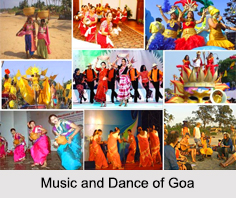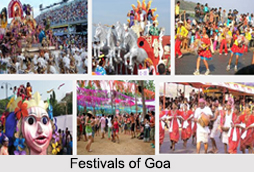 The culture of Goa has been influenced by the age old traditions of the mighty rulers of various dynasties like the Marathas, Mughals and others who have ruled the region. Colonized by the Portuguese for almost 450 years, the culture of Goa is deeply influenced by theirs" and in the present day it is a synthesis of tradition, religion and modernity.
The culture of Goa has been influenced by the age old traditions of the mighty rulers of various dynasties like the Marathas, Mughals and others who have ruled the region. Colonized by the Portuguese for almost 450 years, the culture of Goa is deeply influenced by theirs" and in the present day it is a synthesis of tradition, religion and modernity.
Thus it can be stated that Goa`s cultural heritage was enriched by a slow but incessant process of absorption and assimilation of the more congenial features of alien culture. Discussed elaborately below are some of the most important aspects of the culture of Goa:
Music and Dance of Goa
With a blend of the east and the west, the Goan music is a combination of Indian classical and western music, which has given birth to different forms of music. The Mando and Dulpod are the main traditional Goan musical dance forms. The Goan Hindus are fond of religious performance art forms like bhajan, kirtan and even natak. Some of the popular Indian classical musicians like Kishori Amonkar, Kesarbai Kerkar and Jitendra Abhisheki hail from Goa. Other than Indian classical music, the musical scene of Goa is also entrenched with the likes of trance, Western classic music, techno, jazz, blues, etc.
Each occasion has a distinctive form of dance and music associated to it. The diverse musical instruments that accompany both folk songs and the folk dances are ghumats, cymbals and drums, flutes, harmonium, violins and guitars. Few of the other folk dance forms in Goa are Bhandap, Corredinho, Dekhni, Dhangar Dance, Ghode Modni, Goff, Kala Dashavatar, Lamp Dance, etc. These folk dances elicit the rhythmic charm, the colourful variety and vitality of the culture of Goa.
Independence in India brought about a cultural renaissance in Goa in harmony with providing a fresh impetus to the classic literature and fine arts and a revival of the folk arts. These folk music and folk dances have now crossed the borders of the state and become popular in the rest of the country during the past 25 years.
 Festivals of Goa
Festivals of Goa
Goa is famous for its feasts and festivals. Being under the patronage of mighty rulers like Portuguese, Mughal, Muslims have contributed to a kaleidoscope of festivals. Festivals are celebrated during different occasions such as harvesting season, Shigmo, Carnival, Sao Jao Festival, Christmas, Feast of St Francis Xavier, Ganesh Chaturthi, Diwali and others. These festivals draw together people of all walks of life and of all communities. These fairs and festivals in Goa reflect the state`s beliefs and age old cultures.
Art and Craft of Goa
The art and craft of Goa is an amalgamation of Portuguese and Indian cultures. The crafts of Goa are intricately beautiful, capturing the fancies of tourists and locals alike. The major art forms of the state include creative pottery, bamboo work, woodcarving, brass metals, seashell craft, Paper-Mache, and wooden lacquer ware.
Other important crafts of the state include plaster of Paris, fibre and batik prints, jute macramé, crochet and embroidery, metal embossing, cotton dolls, artistic weaving, jute macramé, silver and imitation jewellery, coconut shell carving, fibre stone carving and many others. Goan art and craft works has carved a niche in the creative field and are sold in various handicraft emporia in major tourist spots.
Cuisine of Goa
The culture of Goa is primarily reflected by its exquisite cuisine, which is a perfect blend of diverse food cultures - the Konkan, the Portuguese and the Bahamani Nawabi. The Goan cuisine has significant influence of Portuguese, Hindu and Muslim. The major attractions of the cuisine take in sea-fruits, fish, prawns, mussels, oysters, crabs, feni, gin and many more.
The principal stable food of Goa includes fish, rice and coconut. Coconut milk forms a major ingredient of Goan dishes and so is "Kokum` which is a kind of fruit. Sea foods also form an important part of the cuisine of Goa. The cuisine of Goa can mainly be divided into two categories; Goan Hindu Cuisine and Goan Catholic Cuisine. The Hindu Cuisine comprises of less spicy, less oily foods. Ingredients like lentils, vegetables, gourd, pumpkins, shoots, bamboo and roots are used in plenty for the preparations of the various dishes. Both non-vegetarian and vegetarian dishes are a part of Goan Hindu cuisines. The Goan Catholic Cuisine is influenced by the Konkani, South Indian, Portuguese, British and Saraswat cuisines.
Goan Literature
Goan literature has been quite diverse and facilitates in the amalgamation of the culture of Goa. Konkani language belongs to the group of Indo-Aryan languages and has been the most dominating. It is an Indo-Aryan language and mostly spoken in the western coast of Maharashtra. In the 16th century, Christian missionaries studied in deep, Konkani language only to spread their religion among the common people. They even set Konkani grammar, dictionaries and studied various facets of literature.
The first Konkani grammar was prepared in 1563 by a Goan priest at St. Paulo College at Old Goa. Gradually Konkani literature contributed to the development of poetries, short stories, essays, novels, dramas. It also specialised in areas like travelogues, journalism etc. Thus the notable writers and scholars with their distinguished work on Konkani literature have significantly portrayed the history, culture, folklore of Goa.
Tourism in Goa
The cultural heritage of Goa consists of the numerous churches, beaches, temples and mosques which have managed to preserve the state"s culture and in turn has facilitated tourism. Major tourist attractions include the Bom Jesus Basilica, Aguada Fort along with the other Forts in Goa, a wax museum on Indian culture, and a heritage museum. The churches and convents of Goa have been declared a World Heritage Site by UNESCO. It is the Portuguese inspired architecture of these historical sites and buildings that also showcase the life and culture of Goa.
This former Portuguese colony, Goa was known as the "Rome of the East" and is today considered as the most westernized state in the Indian Territory. The culture of Goa is an amalgamation of the various things that make the state unique like its music, dance, art forms, language, cuisine, tourism and even architecture, among others.






